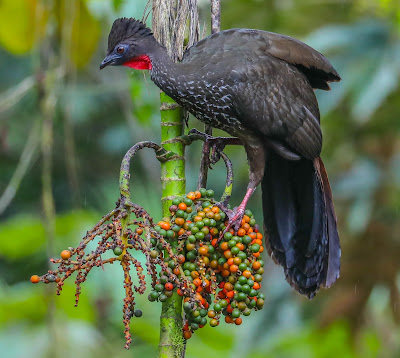The pale-mandibled aracari is a toucan found in western Ecuador and Peru which is considered to be a separate species by some bird authorities and a subspecies of the collared aracari by other authorities (probably the majority). Other names for it I think are descriptive, including red-backed, red-rumped and scarlet-rumped aracari. That is all
Wikipedia and
eBird really have to say about it. If you go to eBird for
collared aracari you don't get much more, but
Wikipedia opens up a little bit. Wikipedia notes that the pale-billed is considered by some to be a subspecies, then goes into three subspecies that are subspecies and says nothing more about the pale-billed. However, some of the other names for the collared are appropriate, such as spot-chested, banded and ringed-aracari.




Descriptive-wise, Wikipedia notes it has a "reddish-collar on the rear-neck" which gives rise to its name, black head and chest, olive-green upperparts, a red rump and upper tail. The underparts are bright yellow with a round black spot in the center of the breast, a red-tinted black band across the belly, chestnut thighs, bare black facial skin becoming ruddy behind the yellow eye, a dull yellow upper mandible with a black saw-tooth pattern on the cutting edge and a black tip, a black lower mandible and green legs.






Before I go on, I just have to say that I think this bird is the most beautiful bird I've ever seen. I am mesmerized by it. It reminds me of a native tribesman dressed for war, face and body streaked with paint. It is not just the colors, but the shapes. The black bullseye with radiating red, the serrated upper mandible, chestnut leggings, ornamental red behind the eye, bright yellow eye and the little bit of green sheen on the back. Beautiful may not be the right word. Perhaps handsome is better.
Now, how this bird varies from the Wikipedia description. I don't see a reddish collar on the rear neck. It has a black head and chest, at least as much as photos for the real "collared" aracari, but the ruddy facial skin behind the eye which is barely visible in some photos I've looked at are huge sections of crimson skin in this bird, which nearly surround the eye and go almost to the back of the head, at least on one I saw, but not so much on another (perhaps a breeding trait). The dull yellow upper mandible with a black tip is much more brightly yellow on this one, with a bright yellow instead of black tip. The black lower mandible is transformed into a mostly yellow lower mandible with black toward the tip. The black spot in the center of the chest has substantial radiating red, much more than in the photos of other collared aracari.
 |
| A good showing of the chestnut thigh, yellow rump, greenish feet and lack of red collar. |
 |
| I nice side view with the red rump, chestnut thigh, huge naked red skin behind and around the eye and the highly yellow bill with flashes of red, on both mandibles, at the base of the ill. |
 |
| This bird reveals the red back and substantially smaller naked red skin behind the eye |
 |
The center black spot and radiating red, surrounded by yellow, is one of the most distinctive features.
Now I realize I've failed to say where I saw this handsome bird. It was at the Milpe Bird Sanctuary outside of Mindo in Ecuador. This one bird made that visit worthwhile, but we did see other wonderful birds in addition. |






















































